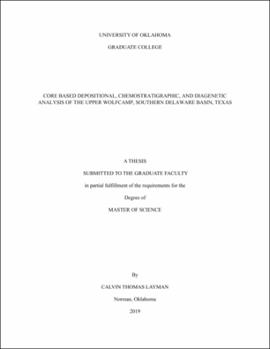| dc.contributor.advisor | Elmore, R. Douglas | |
| dc.contributor.author | Layman, Calvin | |
| dc.date.accessioned | 2019-05-10T19:29:48Z | |
| dc.date.available | 2019-05-10T19:29:48Z | |
| dc.date.issued | 2019-05-10 | |
| dc.identifier.uri | https://hdl.handle.net/11244/319709 | |
| dc.description.abstract | The Wolfcamp Series in the Southern Delaware Basin of West Texas is Permian in age and is composed of a mix of siliciclastics and carbonates deposited through pelagic sedimentation, turbidity currents, and mass wasting in a deep-water environment. A more isolated depositional system was present in the study area than in the rest of the Southern Delaware basin during Wolfcamp time. The Central Basin Platform to the East, and the Waha and Coyanosa structural features to the West and South form a mini basin in northern Pecos County. Isolation resulted in lithologies with less siliciclastic input compared to other areas in the Southern Delaware Basin. One objective of the study is to determine the depositional setting for the Wolfcamp Formation in this sub basin in order to characterize the reservoir and specifically test if a turbidite fan model is applicable to the Wolfcamp Formation in this study area. A second objective is to characterize the diagenesis and test if there is evidence for alteration by late fluids.
Using a core from the Southern Delaware Basin, the reservoir characteristics of the upper Wolfcamp are being analyzed. Eight different lithofacies were observed in the core. Two of the more siliceous lithofacies have the best reservoir characteristics. Based on observed depositional features, stacking patterns, chemostratigraphic proxies, log character, and thin section observations, it is hypothesized that a channelized submarine fan system was active off the Central Basin Platform during Upper Wolfcamp deposition in the study area. An overall coarsening upward package is interpreted as the system was prograding out into the basin. Levee deposits, lobes, and channel fill deposits are present in the cored interval.
Diagenesis is complex, with multiple stages and multiple paragenetic sequences observed throughout the core. Different lithologies have experienced varying degrees of diagenesis. The carbonate clasts inherited diagenetic features from the source area and record events during late diagenesis in the basin. Mudstones features that are both internally and externally sourced phases. Early diagenesis contains phases that are primarily self-sourced. Middle and late diagenesis contains mineralized fractures and other diagenetic phases acquired from external fluids migrating through the system. | en_US |
| dc.language | en_US | en_US |
| dc.rights | Attribution-NonCommercial-NoDerivatives 4.0 International | * |
| dc.rights.uri | https://creativecommons.org/licenses/by-nc-nd/4.0/ | * |
| dc.subject | Delaware Basin | en_US |
| dc.subject | Wolfcamp | en_US |
| dc.subject | Deposition | en_US |
| dc.subject | Chemostratigraphy | en_US |
| dc.subject | Diagenesis | en_US |
| dc.title | CORE BASED DEPOSITIONAL, CHEMOSTRATIGRAPHIC, AND DIAGENETIC ANALYSIS OF THE UPPER WOLFCAMP, SOUTHERN DELAWARE BASIN, TEXAS | en_US |
| dc.contributor.committeeMember | Pigott, John D. | |
| dc.contributor.committeeMember | Pranter, Matthew J. | |
| dc.date.manuscript | 2019-05-09 | |
| dc.thesis.degree | Master of Science | en_US |
| ou.group | Mewbourne College of Earth and Energy::Conoco Phillips School of Geology and Geophysics | en_US |
| shareok.nativefileaccess | restricted | en_US |

